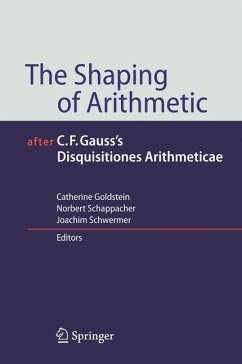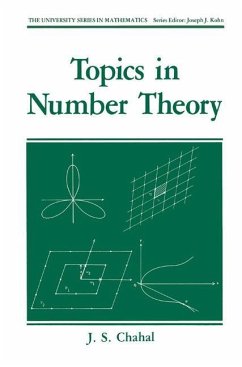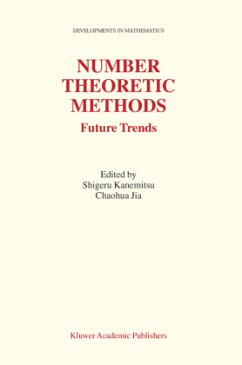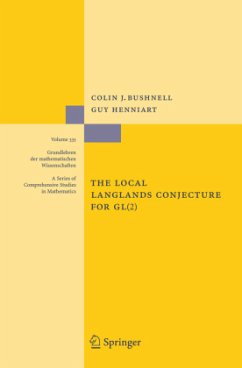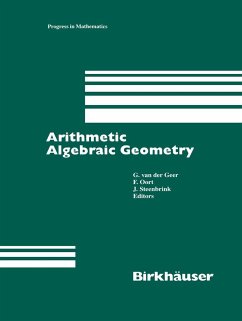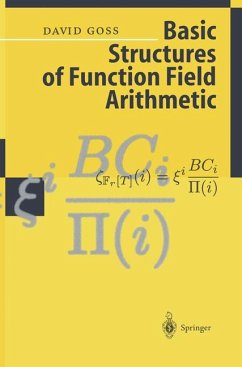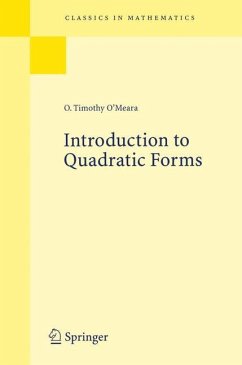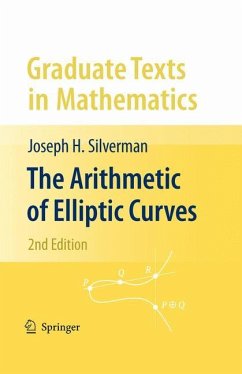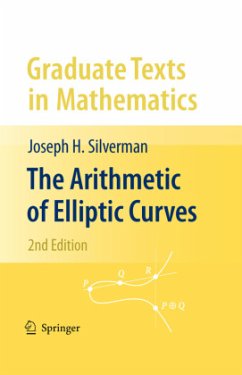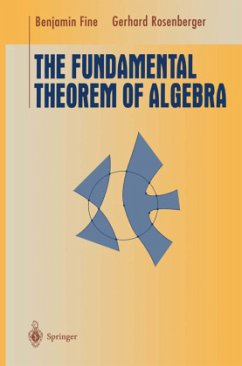
Broschiertes Buch
The Shaping of Arithmetic after C.F. Gauss's Disquisitiones Arithmeticae
Versandkostenfrei!
Versandfertig in 1-2 Wochen
Weitere Ausgaben:

PAYBACK Punkte
39 °P sammeln!





Since its publication, C.F. Gauss's Disquisitiones Arithmeticae (1801) has acquired an almost mythical reputation, standing as an ideal of exposition in notation, problems and methods; as a model of organisation and theory building; and as a source of mathematical inspiration. Eighteen authors - mathematicians, historians, philosophers - have collaborated in this volume to assess the impact of the Disquisitiones, in the two centuries since its publication.
Catherine Goldstein is Directrice de recherches du CNRS and works at the Institut de mathématiques de Jussieu (Paris, France). She is the author of "Un théorème de Fermat et ses lecteurs" (1995) and a coeditor of "Mathematical Europe: History, Myth, Identity"(1996). Her research aims at developing a social history of mathematical practices and results, combining close readings and a network analysis of texts. Her current projects include the study of mathematical sciences through World War I and of experimentation in XVII th-century number theory. Norbert Schappacher is professor of mathematics at Université Louis Pasteur, Strasbourg.His mathematical interests relate to the arithmetic of elliptic curves.But his current research projects lie in the history of mathematics. Specifically, he focuses on the intertwinement of philosophical and political categories with major junctures in the development of mathematical disciplines in the XIX\up{th} and XX\up{th} centuries. Examples include number theory and algebraic geometry, but also medical statistics. Joachim Schwermer is professor of mathematics at University of Vienna. In addition, he serves as scientific director at the Erwin-Schroedinger International Institute for Mathematical Physics, Vienna. His research interests lie in number theory and algebra, in particular, in questions arising in arithmetic algebraic geometry and the theory of automorphic forms. He takes a keen interest in the mathematical sciences in the XIX\up{th} and XX\up{th} centuries in their historical context.
Produktdetails
- Verlag: Springer / Springer Berlin Heidelberg / Springer, Berlin
- Artikelnr. des Verlages: 978-3-642-05802-8
- Softcover reprint of hardcover 1st edition 2007
- Seitenzahl: 592
- Erscheinungstermin: 12. Februar 2010
- Englisch
- Abmessung: 235mm x 155mm x 32mm
- Gewicht: 884g
- ISBN-13: 9783642058028
- ISBN-10: 3642058027
- Artikelnr.: 32056715
Herstellerkennzeichnung
Springer-Verlag GmbH
Tiergartenstr. 17
69121 Heidelberg
ProductSafety@springernature.com
From the reviews:
"A book that traces the profound effect Gauss's masterpiece has had on mathematics over the past two centuries. ... The shaping of arithmetic is a major accomplishment, one which will stand as an important reference work on the history of number theory for many years. ... The editors and authors deserve our thanks for their efforts." (Victor J. Katz, Mathematical Reviews, Issue 2008 h)
"It's a big book, with eighteen authors and almost six hundred pages, and it mixes the work of well-established scholars with that of recent Ph.D.'s. ... This volume deserves a wide audience, both among the mathematically able and among historians of nineteenth-century science." (Thomas Archibald, Institute for Science and International Security, Vol. 102 (2), June, 2011)
"A book that traces the profound effect Gauss's masterpiece has had on mathematics over the past two centuries. ... The shaping of arithmetic is a major accomplishment, one which will stand as an important reference work on the history of number theory for many years. ... The editors and authors deserve our thanks for their efforts." (Victor J. Katz, Mathematical Reviews, Issue 2008 h)
"It's a big book, with eighteen authors and almost six hundred pages, and it mixes the work of well-established scholars with that of recent Ph.D.'s. ... This volume deserves a wide audience, both among the mathematically able and among historians of nineteenth-century science." (Thomas Archibald, Institute for Science and International Security, Vol. 102 (2), June, 2011)
Aus den Rezensionen: "... Im Buch wird Wert darauf gelegt, die Herausbildung der Zahlentheorie auch in eine breitere Geschichte der Mathematik einzubetten. ... Für mathematisch vorgebildete Leserinnen und Leser finden sich je nach Geschmack verschiedene Schmuckstücke. So wirft die Publikation und Auswertung eines Manuskripts von Kummer durch Bölling ein aufschlussreiches Licht auf die Entstehung der Kummer'schen idealen Zahlen. ... Insgesamt gesehen handelt sich um ein beeindruckendes und empfehlenswertes Werk über die Geschichte der Zahlentheorie des 19. Jahrhunderts mit Ausblicken auf das folgende." (Erhard Scholz, in: NTM - Zeitschrift für Geschichte der Wissenschaften, Technik und Medizin, 2009, Issue 17, S. 235ff)
Für dieses Produkt wurde noch keine Bewertung abgegeben. Wir würden uns sehr freuen, wenn du die erste Bewertung schreibst!
Eine Bewertung schreiben
Eine Bewertung schreiben
Andere Kunden interessierten sich für




